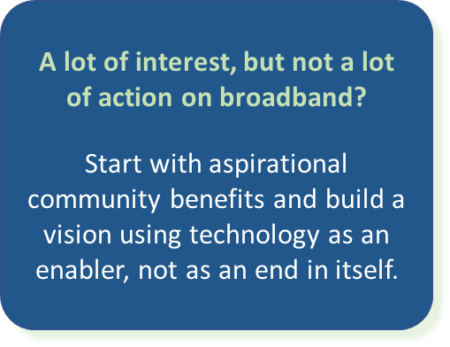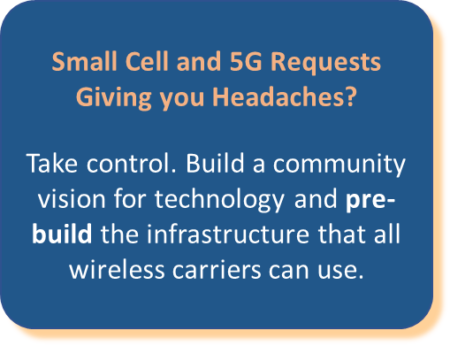Community Vision
Building a Community Vision for investing in Technology
“There are many ways of going forward, but only one way of standing still.” ~ Franklin D. Roosevelt
 The technology challenge for communities is the gap between what is profitable for commercial providers in serving part of the community and what is now necessary digital infrastructure for all members of the community. It is up to local leaders to proactively address this gap, driven by a clear and aspirational vision for their community’s future.
The technology challenge for communities is the gap between what is profitable for commercial providers in serving part of the community and what is now necessary digital infrastructure for all members of the community. It is up to local leaders to proactively address this gap, driven by a clear and aspirational vision for their community’s future.
Communities face many challenges. That is nothing new. What is new are the increasing breadth of challenges and the accelerating pace of change. These stresses put more and more demand on community leaders to lead and keep pace in an ever-changing world, often with limited or decreasing budgets. Standing still is not an option, yet having a vision to guide how you move forward is no simple task.
 Adapting to, and embracing, change requires a vision of the future to overcome inertia of how things have been done in the past. Change will happen. You either make change happen on your terms, or it will happen to you on others’ terms. This is especially true of technological change and, in particular, broadband as an essential digital infrastructure for the community.
Adapting to, and embracing, change requires a vision of the future to overcome inertia of how things have been done in the past. Change will happen. You either make change happen on your terms, or it will happen to you on others’ terms. This is especially true of technological change and, in particular, broadband as an essential digital infrastructure for the community.
In the absence of a vision for your community’s digital infrastructure, technology will be imposed on your leadership, driven both by the demands of your citizens and by the commercial pressures from service providers. This can result in an uncoordinated patchwork of solutions that the community must react to at an accelerating pace, rather than an integrated platform of solutions with the community in control of its future. It is up to local leaders to create a clear and aspirational vision for their community’s future.
What should such a vision look like?
1. Technology is not an end in itself, but an enabler to addressing needs
A community’s vision for technology should be founded on its sustainable development goals. Is it economic development opportunities, new ways of working together, improved access to education opportunities, health care, etc.? Every community has its own priorities to meet current and expected needs. With clarity of goals and with an aspirational vision, local leadership can identify what the specific community needs are and how technology can solve them. Technological solutions should look to the future and be assessed on their economic feasibility, i.e. whether or not community benefits outweigh costs, which include municipal cost reductions, quality of service improvements, etc.
2. Digital infrastructure as a platform for the community
 In whatever way it is implemented (built, financed, leased), digital infrastructure should be designed as a platform for the community – one that is integrated and uses, or enables, a mix of technologies. The platform becomes the basis for the community to enable services and applications for all in the community.
In whatever way it is implemented (built, financed, leased), digital infrastructure should be designed as a platform for the community – one that is integrated and uses, or enables, a mix of technologies. The platform becomes the basis for the community to enable services and applications for all in the community.
The challenge for communities is when disparate service providers request, or demand permits and overbuilds on a piecemeal and ad hoc basis. This can be avoided by inviting them to integrate onto digital infrastructure for which they do not have to pay, that has greater capacity than they would invest in, and reaches more households and businesses than they could afford to connect. Communities build and maintain roads because they are essential infrastructure for all to use and for which there is not enough of a private sector business case – digital infrastructure is the same when factoring-in economic impacts, community benefits, and smart community services.
3. Community ownership, while fostering partnerships and collaboration
Community ownership of digital infrastructure enables leadership to better ensure that all community members have affordable and robust internet access, as well as manage municipal telecommunication and internet costs. Like road networks, digital infrastructure should be an enabling platform designed to be inclusive and adapt to evolving needs. Local investment in infrastructure lowers the barriers for service and content providers to bring their value to the community on a partnership or collaborative basis. Taking ownership of your digital future is hard, complicated, and a long-term process – but necessary in order to be competitive and stay relevant in an increasingly online economy.
4. Flexible and scalable to meet changing needs and priorities
Community needs and technological change can never be fully predicted, and the pace of change will only accelerate over time. The digital infrastructure platform must be flexible to meet the right needs at the right time and open to technological advancement, and it must be able to scale to those needs when required.
5. Enable competition and leverage innovation
Through an open approach, with the community platform as an enabling infrastructure (again, like roads), the community can welcome many providers of services and content that meet their standards and requirements. This encourages healthy competition, as well as a wide set of complementary services. Community members themselves have the opportunity to provide innovative solutions for the benefit of the community as a whole. Rather than simply taking whatever external providers want to offer, the community, through its own priorities and needs, determines its future.
“Progressiveness means not standing still when everything else is moving.” ~ Woodrow Wilson
Whether your community priorities are to overcome poor broadband connectivity (as many localities are), or whether you are looking to the future toward smart community services in anticipation of changing needs, you need to create a vision for your future. Your vision will need to be based on the unique characteristics of your community, your unique challenges, and your long-term goals.
 We at Strategic Networks Group understand the importance of defining your own clear vision and getting yourself into a position to be ready to move forward. We have been researching the value and importance of digital infrastructure and broadband for decades. We have quantified the benefits to communities, their citizens, and their businesses in terms of economic growth and improvements in quality of life. With this data and the unique insights, we have developed a suite of methods to help community leaders take action.
We at Strategic Networks Group understand the importance of defining your own clear vision and getting yourself into a position to be ready to move forward. We have been researching the value and importance of digital infrastructure and broadband for decades. We have quantified the benefits to communities, their citizens, and their businesses in terms of economic growth and improvements in quality of life. With this data and the unique insights, we have developed a suite of methods to help community leaders take action.
As a starting point we welcome you to use our complimentary Digital Needs and Readiness Assessment designed to assist you in clarifying your needs and goals and to assess your state of readiness to move forward. If standing still is not an option, then taking the right first step is essential.
